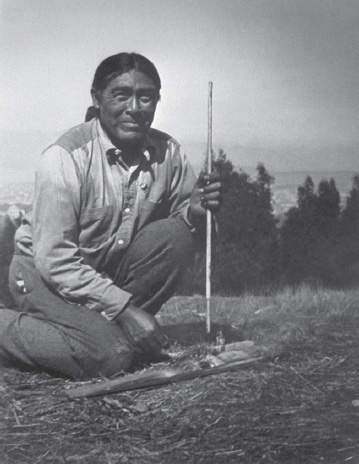PORTRAIT Ishi, The Last of His People
In late August of 1911, an emaciated and nearly naked man, about fifty years old, staggered into the corral of a slaughterhouse in northern California. As it turned out, he was the last member of his people, a gathering and hunting group known as the Yahi, pushed into extinction by the intrusion of more powerful farming, herding, and “civilized” societies. It was a very old story, played out for over 10,000 years since the Agricultural Revolution placed Paleolithic cultures on the defensive, inexorably eroding their presence on the earth. The tragic story of this individual allows us to put a human face on that enormous and largely unrecorded process.

Within a few days, this bedraggled and no doubt bewildered man was taken into the care of several anthropologists from the University of California, who brought him to a museum in San Francisco, where he lived until his death from tuberculosis in 1916. They called him Ishi, which means “person” in his native language, because he was unwilling to provide them with his own given name. In his culture, it was highly impolite to reveal one’s name, especially to strangers.
In the mid-nineteenth century, the Yahi consisted of about 300 to 400 people living in a rugged and mountainous area of northern California. There they hunted, fished, gathered acorns, and otherwise provided for themselves in a fashion familiar to gathering and hunting peoples the world over. But the 1849 California gold rush brought a massive influx of American settlers, miners, and farmers that quickly pushed the Yahi to the edge of extinction. Yahi raiding and resistance was met by massacres at the hands of local militias and vigilantes, only too glad to “clean up the Indians,” killing and scalping hundreds. One such massacre in 1865 likely killed Ishi’s father, while the young Ishi, his mother, and a few others escaped.
By 1870, Ishi’s community had dwindled to fifteen or sixteen people, living in an even more inaccessible region of their homeland. In these desperate circumstances, traditional gender roles blurred, even as they undertook great efforts to conceal their presence. To avoid making footprints when traveling, they jumped from rock to rock; they ground acorns on smooth stones rather than on more obvious hollowed out rocks and carefully camouflaged their thatched dwellings and campfires. By 1894, this tiny Yahi community numbered only five people: Ishi, his mother, his sister or cousin, and an older man and woman.
Then in 1908, a group of American surveyors came across a naked Ishi harpooning fish in the river, and a few days later they found the tiny settlement that sheltered the remaining Yahi. Only Ishi’s aged mother was present, hidden under a pile of skins and rags. They did not harm her, but they took away every moveable item—tools, food, baskets, bows and arrows—as souvenirs. Ishi returned to carry his mother away and she soon died. He never saw his sister/cousin or the others again. For some time, then, Ishi lived absolutely alone until he stumbled into the slaughterhouse on August 29, 1911, his hair burned short in a Yahi sign of mourning.
In his new home in the museum, Ishi became something of a media sensation, willingly demonstrating his skills for visitors—fashioning tools and weapons of stone and bone, starting a fire, but refusing to make baskets, because it was women’s work. Actively cooperating with anthropologists who sought to document the culture of his people, he took them on a hunt one summer, teaching them how to track and kill deer and to process the meat on the spot. All who met him remarked on his gentleness and kindness, his love of company, his delight in children, his fondness for laughing and joking. According to Alfred Kroeber, the primary anthropologist involved with Ishi: “He was the most patient man I ever knew . . . without trace of self-pity or of bitterness to dull the purity of his cheerful enduringness.”24
Question
Questions: What accounts for the ability of Ishi’s people to survive into the twentieth century? What emotional or moral posture toward Ishi’s life seems most appropriate? What perspective does it lend to the larger story of the gradual erosion of gathering and hunting societies the world over?